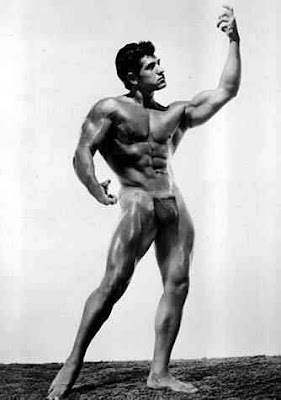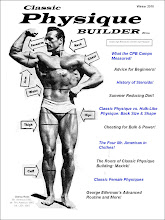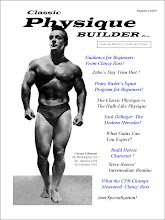
(Photo above: Classic Physique Builder Reg Lewis - Mr. Northern California 1955, Mr. Pacific Coast 1956)
One of the keys to building a classic physique is in understanding what we call the Classic Physique Building (CPB) Principles. These are the principles of weight training that were discovered, developed, and named in the Golden Age of Classic Physique Building (the 1940s and 50s).
These principles were discovered, largely, by trial and error by the Golden Age champs. Joe Weider was responsible for giving many of these principles "catchy names" and promoting them to his readers. So many of them became known as the "Weider Principles." These names now form some of the modern "vocabulary" of weight training. So the CPB Principles (as we call them) include the "Weider" principles and others (named by others or named by us) that were utilized during the Golden Age.
Although it may sound too basic, it is best to start off with discussing the CPB Principle of Progressive Resistance. This is one of the most important and foundational principles of building a classic physique. The principle is this - muscles grow in response to progressive resistance. In other words, a muscle will get larger in response to lifting progressively heavier weights over time.
As basic as this is, we are continually surprised in the gym when we see people - day in and day out, for weeks and weeks on end - continue to perform the same exercise using the same weight and same number of sets! We recall seeing a poor fellow who is always in the gym, always does bench presses with 20 lbs on an Olympic bar, and always does the same number of reps and sets! Of course, this fellow never grows! His physique never changes. His problem is that, although he is persistent (which is good), he doesn't understand the CPB Principle of Progressive Resistance.
So if you want to increase your muscle mass (for any body part) for building a classic physique, you must strive to continually push your weights (poundages) up in your exercises. For example, if a workout routine calls for doing 2 sets of 8 reps, what does that mean? It means you should pick a weight that allows you to just barely complete the 8th rep (in other words, doing a 9th rep would not be possible) on your first set. Then after resting for a minute, you might be able to do 6-7 reps on your second set with the same weight. If this happens, then you've picked the correct weight. Now, after a few workouts, you get stronger and find that you can easily complete 8 reps on both sets! This means, you've gotten stronger AND a little bigger (even if you can't measure the size increase yet). So now, you MUST increase your weight! How much? Increase it so that, like before, you can barely complete your 8th rep on your first set and 6-7 reps on your second. Then repeat the same process (after a few workouts when you can easily complete 8 reps on both sets, increase the weight again).
Understanding and using this principle correctly will be your first and foundational key to muscle growth (whether you are younger or older)! It is not the only CPB principle - but it is, perhaps, the most important one to understand at the beginning of your training. And regardless of what other principles you use, this one should be the cornerstone of your training if you want to gain size.
So check your workout routine. Have you been performing the same exercises, with the same weights and same reps, and feeling like you are getting nowhere? If so, perhaps you now understand why. Just take a week lay off, adjust your workout routine to include the CPB Principle of Progressive Resistance and then start up again! Assuming that you are not overtraining your muscles (with too many exercises, too many sets, or too many workouts per week), and that you are eating and resting properly, you should start to see some gains!
Stay tuned for future posts on CPB Principles!
- CPB













